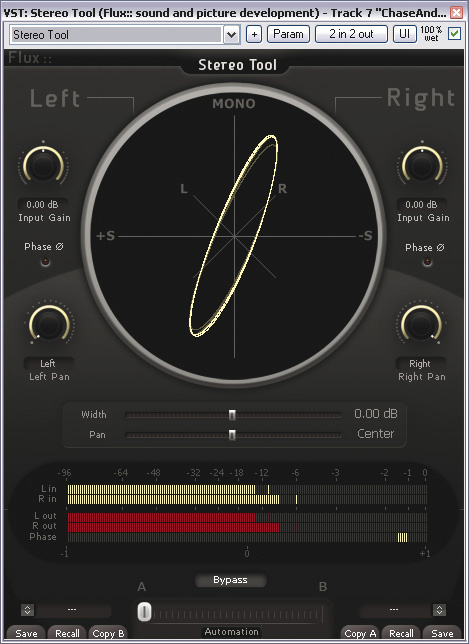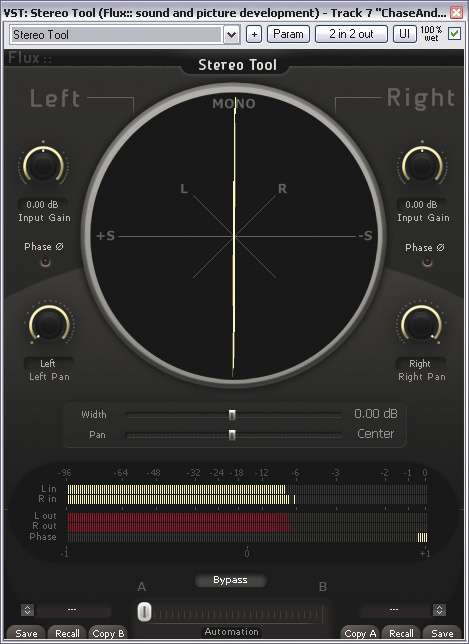
There are lots of points of interest here, not least the way distortion allows the lead vocals to maintain some presence in the face of the backing track’s full-frequency assault — a long-standing trick in heavy rock music, which is equally applicable to slab-like saturated synth textures like this. I also love the way the arrangement is constantly evolving through time. Take the first verse (0:27-0:55) for instance. It starts by dropping the drums with a low-end ‘boom’ one-shot and a sizzly HF transition effect. The first vocal phrase follows shortly after, by the end of which the backing has already thinned out and become more muted, to give the sonic details of the voice, high synth riff, and their delay effects a few moments in the spotlight. By the time the second vocal phrase has finished, though, the synth bed is already becoming edgier and more filter-modulated, leading towards the vocal delay spin on the word ‘I’ at 0:40.
Then the tambourine/shaker subtly increase the rhythmic drive and a hint of low bass appears as the synths begin to fade in and open their filters. At 0:48, a siren sound emerges from somewhere below 200Hz and slowly slides upwards to connect with the strong 658Hz fundamental of the vocal ‘Ho!’ at 0:53, while the shadowy low end fades out again in preparation for the main chorus bass part. It’s this kind of continual ebb and flow that seems to typify a lot of the most commercially successful dance music, and Chase & Status exemplify a wide variety of techniques here which you can readily adapt to enhance your own electronica tracks.
The drums and bass are worthy of attention too. The snare has a good chunk of low end to it (another connection with classic rock records), specifically a strong pitched component at 172Hz. Try notching out that frequency with EQ and you’ll quickly realise how significantly it affects the drum’s subjective power. By giving more low end to the snare like this, it doesn’t need to fight as much with the synths and vocals in the 3-5kHz presence region, which helps avoid harshness creeping into the overall mix tonality. It’s also worth noting that 172Hz is an F, a note which works pretty well with all the main chords of the song: a 7th of G major, the third of D minor, and the root of F major. By virtue of this, the 172Hz component sinks into the track, contributing power without drawing too much attention to its pitched nature.
The kick rolls off pretty rapidly below 60Hz, as you can hear easily at 0:13, leaving a clear window for the 35-50Hz bass-line fundamentals. Despite this, the low end of this record is not as solid and powerful as it could be, for two reasons. The first is that the levels of the bass fundamentals are quite inconsistent. Compare the D notes at 0:57 and 1:04, for example. The fundamental of the latter is considerably stronger (to the tune of about 6dB, judging by my spectrum analysers). Compressing the low frequencies is no remedy, though, because of another problem: the left and right LF channels aren’t well matched, either in terms of level or phase. In other words, in a stereo speaker system, the combined bass output of the speakers will suffer because one of the woofers is usually producing less fundamental than the other; while on a mono system, partial phase-cancellation adds further variability in the combined bass level.
You can easily identify low-end phase mismatch by sending a steeply low-pass-filtered version of the mix to a stereo vectorscope. In ‘Blind Faith’ you get an oval trace:

…whereas a production that’s better behaved in this regard (Pendulum’s ‘Watercolour’, say) exhibits something close to a straight vertical line with a filter cutoff of 80Hz or so:

To hear what I’m talking about, listen to the F bass note at 3:09. It starts off with the channels partially out of phase, then drifts into phase towards the middle of the note’s duration, before sliding back out of alignment again. The result in mono is a noticeable low-end swell (maybe 3dB) towards the middle of the note, and this is the kind of instability that’s present right through the track.










